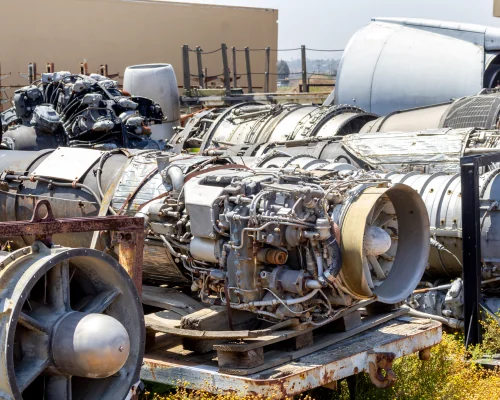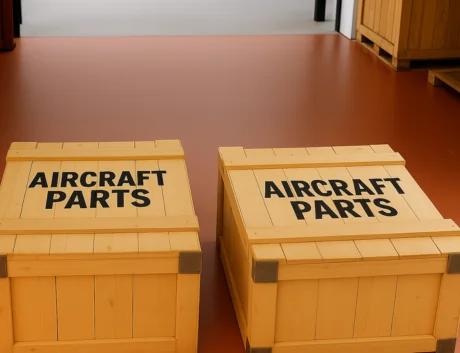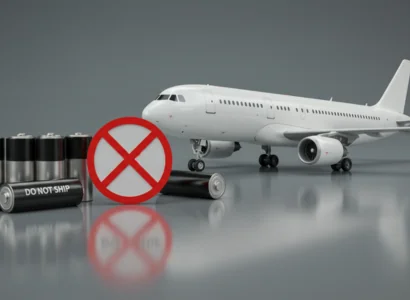
Shipping Aircraft Parts
Fast. Secure. Compliant. Freight Shipping for Aircraft Parts.
Whether you're moving a jet engine component, avionics systems, or a crate of precision aerospace hardware, FreightCenter provides the logistics expertise and carrier network to deliver safely and on time. Our aircraft parts shipping solutions are trusted by manufacturers, MRO providers, and aerospace distributors nationwide.
Precision Parts. Precision Shipping.
At FreightCenter, we understand the unique logistics challenges of shipping aircraft parts, and we offer a range of tailored shipping options to meet your specific needs. Whether you’re transporting aircraft engines, propellers, or any other critical components, we provide solutions for different shipment sizes. The two significant types of freight shipping are LTL (less-than-truckload) and FTL (full truckload). Now, if the load is bigger in size, it may be ideal to look into Flatbed shipping.
Ensuring cost-effective and efficient transportation for both small and large aircraft parts. We leverage a vast carrier network specializing in heavy and oversized shipments, which enables us to match your cargo with the most suitable carrier for secure and timely delivery. With FreightCenter, you can count on reliable, safe, and timely transportation for all your aircraft part shipping requirements.
Thousands of businesses trust FreightCenter to move their freight faster, smarter, and cheaper! From unbeatable rates to top-notch service, our customers are raving about their shipping success.
See why they keep coming back!
Award-Winning Service, Trusted by Shippers Everywhere!
- 2021, 2017 & 2016 Food Logistics’ Top Green Providers
- 2021 & 2018 Supply & Demand Chain Executives’ Pros to Know: Matthew Brosious
- 2020 & 2019 Top Food Logistics’ 3PL & Cold Storage Provider Award
- 2020 & 2019 Business Observer’s Top 500 Companies on the Gulf Coast
- 2020 & 2017 SmartWay® Transport Partner
- 2020 & 2017 Food Logistics’ Champions: Rock Stars of the Supply Chain
- 2020 Best of Palm Harbor Awards for Local Businesses
- 2017 Green Supply Chain Award from Supply & Demand Chain Executive
- 2017 Tampa Bay Business Journal Heroes at Work
- 2016, 2015, & 2012 Food Logistics Top 100 Software and Technology Providers
- 2013 Tampa Bay Business 100 by Tampa Bay Business Journal
- 2013 Top 100 Great Supply Chain Partners by SupplyChainBrain
- 2012 TIA Samaritan Award Honorable Mention
- 2012, 2011 & 2010 TBBJ Fast 50 Recipient
- 2013, 2011, & 2010 Diversity Business Top Businesses

Why Choose FreightCenter for Shipping Aircraft Parts
Shipping aircraft parts isn’t standard freight—it’s high-value, often time-sensitive, and demands aerospace-grade handling. FreightCenter offers:
-
Access to 50+ carriers experienced in aviation and aerospace logistics
-
Hazmat-certified, TSA-compliant, and airfreight-ready carrier options
-
Expedited, LTL, FTL, and international shipping services
-
Custom packaging and crating coordination for delicate or oversized parts
-
Real-time tracking and expert logistics support from quote to delivery
We specialize in coordinating complex, critical shipments so your components arrive intact, insured, and on schedule.
What Is The Best Way To Ship Aircraft Parts?
After airplane parts are purchased new or sent in for repairs, they must be shipped for installation. While shipping aircraft parts might seem daunting, it’s an easy and cost-effective process with the correct information. Believe it or not, thousands of aircraft parts are available on eBay, Craigslist, and other sales listing and eCommerce sites at any given time.
Although aircraft parts are listed online, they are too large and heavy to be shipped through regular mail. Because of this, freight shipping is the best solution for shipping airplane parts. FreightCenter has helped many aircraft seat buyers, sellers, owners, and repair facilities save time and money by finding the best shipping solutions.
How Do I Pack Aircraft Parts for Shipping?
Whenever you ship your item via LTL freight, it will typically be loaded and unloaded at least six times before reaching its final destination. Generally, it is moved when it is…
- . . picked up to be taken to the originating freight terminal
- . . unloaded at the originating freight terminal
- . . loaded onto the LTL freight trailer, on which it will stay for the long part of the haul
- . . unloaded at the destination freight terminal
- . . loaded onto a truck for delivery
- . . unloaded at the final destination
Having shipped thousands of aircraft components over the years, we’ve learned that proper packaging is essential for both regulatory compliance and the protection of these high-value parts. Here’s how to ensure your aircraft components arrive safely at their destination.
Packaging Standards for Aviation Components
For commercial aviation parts, ATA Spec 300 containers are industry standard:
- Category I containers are designed for 100+ round trips (ideal for frequent shipments)
- Category II containers withstand approximately 10 round-trips (suitable for regular use)
- Category III packaging is single-use but must still meet rigorous protection standards
Military or defense-related shipments require adherence to MIL-STD-2073-1, which has its own specific requirements for preservation, cushioning, and moisture protection.
Crating Materials and Construction
Invest in proper crating materials – hardwood, structural-grade plywood, or metal. For international shipping, ensure all wood materials are ISPM 15 compliant to prevent customs delays.
The interior of your crate should feature custom-fitted foam inserts or other cushioning materials that immobilize the part completely. Even minor movement during transit can cause significant damage to precision components.
Environmental Protection Measures
Aircraft parts require protection from environmental factors:
- Include sufficient desiccant packets and humidity indicators to monitor and control moisture levels.
- Use vapor barrier packaging for components susceptible to corrosion.
- For electronic components and avionics, implement proper anti-static packaging to prevent electrostatic discharge damage.
Securing Heavy Components
Larger components like engines, APUs, or landing gear require special attention:
- Mount these items securely to OEM-approved fixtures within the crate.
- Use proper bolting techniques and torque specifications.
- Distribute weight evenly and provide structural support to prevent shifting.
Documentation and Labeling Requirements
Comprehensive documentation is critical:
- Attach all shipping documents (BOL, commercial invoices, customs forms)
- Include required certificates, such as Purge Certificates for engines.
- Provide complete maintenance logbooks documenting the part’s history.
- Label packaging clearly with orientation instructions, handling warnings, and hazardous material notifications as applicable.
At FreightCenter, we understand the complexities of shipping aircraft parts and can help ensure your valuable components are packaged properly and transported safely. Our experience with aviation logistics means we can guide you through each step of the process, from packaging consultation to final delivery confirmation.
When it comes to shipping aircraft parts, precision and compliance aren’t optional they’re critical. At FreightCenter, we provide tailored freight solutions designed specifically for the aerospace industry, ensuring every shipment is handled with the care and speed your operation demands.
Many aviation shipments—like avionics, flight instruments, or hydraulic assemblies don’t require a full truckload. Our Less-Than-Truckload (LTL) shipping solutions allow you to move smaller aircraft components affordably, while still meeting packaging and handling standards for sensitive or certified parts. We help you choose the correct freight class, prepare the right documentation, and coordinate with carriers familiar with aerospace logistics.
Aircraft-on-ground (AOG) situations demand immediate action. FreightCenter offers expedited freight services specifically suited for shipping time-sensitive aircraft parts across the U.S. We coordinate fast pickups, direct routes, and team-driver options to get your shipment moving and your aircraft back in service—without delay.
For avionics, navigation systems, and other fragile or high-value aircraft parts, we offer white glove shipping services that include special handling, inside pickup/delivery, and packaging support. This is ideal for MRO providers, aerospace manufacturers, or airports receiving specialized cargo that requires extra care.
Need to move large volumes of non-urgent parts, raw materials, or structural assemblies? FreightCenter offers rail freight solutions that are cost-effective and reliable for long-haul shipments. Whether you're supplying a maintenance depot or a manufacturer, rail can reduce costs while maintaining safety and efficiency especially for palletized or crated freight.


Final Factors to Consider When Shipping Aircraft Parts with FreightCenter
When shipping aircraft parts, the smallest oversight can lead to the biggest delays. That’s why choosing the right logistics partner is just as important as how your parts are packaged or labeled. FreightCenter goes beyond quoting rates—we help you ship smarter, safer, and with full regulatory confidence.
Here’s what sets us apart in your final decision:
-
Aerospace-Savvy Carrier Network: We only work with vetted carriers experienced in handling aerospace freight, from avionics to structural components.
-
End-to-End Compliance Support: From ITAR regulations to hazmat classifications, our team ensures every aircraft part is shipped in full alignment with federal and international standards.
-
Custom Routing & Scheduling: Need coordinated drop-offs at an airport hangar, repair facility, or maintenance site? We handle logistics to keep operations running smoothly.
-
Freight Visibility from Quote to Delivery: Real-time tracking and proactive updates keep you informed because, in aviation, downtime isn’t an option.
Whether you’re shipping a single crate or coordinating global part distribution, FreightCenter is your co-pilot in freight. Let’s move your mission-critical cargo with precision.
Shipping Aircraft Parts FAQs
Q. What is the best way to ship aircraft parts?
The best method depends on the size, weight, value, and urgency. FreightCenter offers LTL, FTL, expedited, and international freight solutions tailored to the transportation of aviation and aerospace components.
Q. Can I ship aircraft parts internationally?
Yes, but some parts may fall under ITAR or EAR export regulations. FreightCenter connects you with experienced carriers in international aerospace freight and assists with the required documentation.
Q. Are aircraft parts considered hazardous materials?
Some are. Items like batteries, pressurized components, or parts containing oil may require hazmat classification. FreightCenter helps ensure full DOT and IATA compliance.
Q. How should aircraft parts be packaged for shipping?
Use ATA Spec 300 or custom crating with foam inserts, anti-static materials, and proper labeling. FreightCenter can coordinate packaging services if needed.
Q. Do I need freight insurance for aircraft parts?
Yes, due to the high value and potential liability. FreightCenter offers optional freight insurance and declared value coverage for peace of mind.
Q. Can I ship oversized aircraft components?
Q. How do I label aircraft part shipments properly?
Include part numbers, serial numbers, destination, and any required handling instructions like “Fragile,” “This Side Up,” or “Keep Dry.” Hazmat parts must include the correct placards.
Q. How long does it take to ship aircraft parts?
Domestic shipments can take 1–5 business days, depending on distance and freight mode. Expedited and air freight can shorten this to 1–2 days. FreightCenter provides accurate transit estimates at booking.
Q. o I need to provide a Safety Data Sheet (SDS)?
Yes, if the part includes or contains hazardous materials (e.g., hydraulic fluid, batteries). SDS documents ensure safe handling and compliance with legal requirements.
Q. Can FreightCenter ship aircraft engines?
Yes, we specialize in heavy, high-value freight like engines. We’ll coordinate proper crating, carrier selection, and delivery scheduling.
Q. Is liftgate service available for aircraft part deliveries?
Yes. FreightCenter offers liftgate, inside delivery, and white glove services depending on the delivery location and equipment involved.
Q. What if I don’t have the original packaging?
No problem. FreightCenter can connect you with packaging partners who offer custom crating and ATA-compliant packaging for aircraft components.
Q. Can I track my shipment in real time?
Yes. FreightCenter provides real-time tracking and updates for every shipment, from pickup to delivery.
Q. What is the freight class for aircraft parts?
Freight class varies based on density, size, and handling requirements. Aircraft parts often range from Class 85 to 250. FreightCenter helps calculate this for accurate pricing.
Q. How do I get a quote to ship aircraft parts?
Use our online freight quote tool or call (800) 716-7608 to speak with a specialist. We’ll compare rates and match you with the best carrier for your shipment.
3 Things You Didn’t Know About Shipping Aircraft Parts

Some aircraft parts can’t legally be shipped by air
Because of safety regulations, parts containing lithium batteries, pressurized gas, or flammable materials (like fuel-soaked filters) may be banned from air transport unless they’re packed and labeled to strict IATA and DOT hazmat standards. That means a part for a jet might need to be sent by ground—even during an AOG (Aircraft on Ground) emergency.

Many aircraft components require ATA Spec 300 packaging
The airline industry often mandates that critical parts be packed in ATA Spec 300 Category I containers—meaning they must withstand 100 round trips without failing. This level of packaging ensures the part’s airworthiness and traceability, even when shipping by truck.

One missing label or document can ground an entire shipment
Because of international compliance laws like ITAR, EAR, and hazmat regulations, even minor paperwork errors—like leaving off a serial number or omitting a Safety Data Sheet can delay shipments for days or flag them for inspection. That’s why aviation logistics relies heavily on experienced freight partners like FreightCenter.

